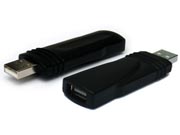How to buy a USB flash drive
 Washington - USB flash drives are hot - and the demand continues to grow. Consumers are snapping up flash drives at a rate of almost 40 million per quarter, according to Santa Clara Consulting Group, and manufacturers big and small - from specialist companies like Lexar to giant electronics behemoths like Toshiba - are getting in on the market.
Washington - USB flash drives are hot - and the demand continues to grow. Consumers are snapping up flash drives at a rate of almost 40 million per quarter, according to Santa Clara Consulting Group, and manufacturers big and small - from specialist companies like Lexar to giant electronics behemoths like Toshiba - are getting in on the market.
For consumers, the proliferation of flash drives is both good and bad. It's good because prices have come way down. It's bad because no two flash drives are built the same, and when you walk into your local electronics store or shop online for a flash drive, you'll be confronted with dozens, if not hundreds, of choices. How can you sort through the options? Here's what to look for.
--- Capacity
Start with capacity. When you go shopping for flash drives, you'll be tempted by prices as low as 10 dollars for a 1 gigabyte (GB) drive. But low price won't do you much good if you quickly outgrow the flash drive you do purchase.
As with hard drives, most people find a way to fill the space available to them on flash drives. Not only can you use the drives as backup devices to store important files from your notebook or desktop, but you can also use them to carry around your music collection, store digital photos while on vacation, and essentially make your digital life portable.
So look at flash drives with larger capacities that are still within your budget. Flash drives with 8 GB are retailing for around 20 dollars these days at online stores such as Newegg. com, while 16 GB models come in at under twice that amount. You can also find 32 GB models for between 60 and 80 dollars. Even 64 GB flash drives now exist, but they cost roughly double the price of the 32 GB models.
--- Speed and compatibility
Don't even think about buying a USB flash drive that's not rated as USB 2.0 compatible. The USB 2.0 specification assures you of backward compatibility with earlier USB versions. It also provides greatly improved speed over the original USB specification when used with a USB 2.0 port.
Beyond the USB standard, though, you should note that not all flash drives read and write data at the same speed. Some drives, especially larger ones, are significantly slower when writing data to the drive than reading data from it. To make matters worse, it can be a bit difficult to compare the speed ratings of various drives, since one manufacturer rates speed at megabytes per second (MB/sec) while others use the "X" ratings - as in 200X - but do not tell you how that equates to a MB/sec rating. Indeed, in practice, two flash drives from different manufacturers but boasting the same MB/sec or X rating may perform differently.
Nevertheless, if speed is of utmost importance to you, spend some time online comparing speed specifications of different models. It can also be helpful to read the reviews of products left by consumers at retail sites that allow users to rate and review the products they've purchased.
In addition, note whether a flash drive is marked as ReadyBoost capable. ReadyBoost is a feature in Windows Vista that allows the operating system to use a flash drive to supplement and augment the memory available to it. In order for a flash drive to be certified as ReadyBoost capable, it must meet certain speed and access time requirements.
--- Lanyards
"Lanyards" are the little caps that cover the USB interface. They're important because they keep the USB part of the flash drive clean and safe while the drive is jangling around in your pocket.
The main problem with lanyards is that because they're removed when the flash drive is in use, they can easily be lost, misplaced, or broken. The best-designed flash drives are built to allow you to store the lanyard on the other end of the flash drive itself. That way, you won't accidentally leave it on a desk or drop it on the floor; it always remains with the flash drive itself.
--- Keyhole
Lots of flash drives are designed so that they can be attached to a key chain when not in use. If you intend to carry your flash drive this way, pay careful attention to how well the key chain loop is constructed. Avoid flash drives that have a plastic loop through which your key chain is supposed to slip. The plastic tab will break, eventually. Instead, look for flash drives that provide a metal loop for attaching the drive to the key chain.
--- Thickness
Some flash drives are quite thin, while others are thicker, presumably to make them easier or more comfortable to handle. While the feel of a flash drive is important, it is more important whether or not it can fit into your USB port.
Lots of USB ports are spaced fairly close to one another. Just look on the back of any notebook computer to see evidence of this. Flash drives that are too thick may be impossible to wiggle into a USB socket if an adjacent port is occupied. Favour thinner flash drives over thick ones.
And that's about it. The trick to buying a flash drive is getting the right one from the start. Use the guidelines here, and hopefully you won't end up with a desk drawer full of old, flawed, or inadequate flash drives that you can't even sell. (dpa)